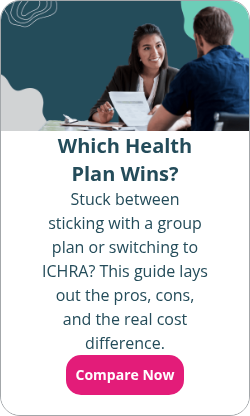Individual health insurance vs. group health insurance
By Elizabeth Walker on December 1, 2025 at 8:15 AM
If you’re an employer focused on attracting and retaining talented workers, having a robust health benefit in your compensation package is essential. But if you’re offering health benefits for the first time, knowing where to start can be overwhelming — especially if you’re a small business owner.
If you’ve done any research into health benefits, you’ve probably heard the terms “group health insurance” and “individual health insurance”. But what’s the difference between the two, and how do they compare?
This article will compare group and individual health insurance, including how they work and how you can take advantage of a health reimbursement arrangement (HRA) with each option.
In this blog post, you’ll learn:
- How group insurance and individual health insurance differ, including how employees can get coverage and the cost factors associated with each.
- The basics of HRAs and how each type works with both group and individual health insurance
- How to determine which health benefit is best for your company, based on flexibility, cost, employee choice, and administrative burden.
How does group health insurance work?
Traditional group health insurance, also known as employer-sponsored coverage or a group plan, is a type of policy that an employer chooses, buys, and offers to eligible employees and their dependents. In 2025, almost 154 million Americans had employer-sponsored health insurance1.
If you choose to offer group insurance, you can exclude your part-time employees from participating in the benefit. However, if you want to include your part-timers, you must make it available to all your part-time staff — you can’t pick and choose which ones will receive it.
Due to the passage of the Affordable Care Act (ACA), fully-insured group insurance providers are no longer allowed to deny coverage to employees with pre-existing health conditions or charge them higher premiums. Their medical history and current health status also won’t affect employee group eligibility, a process known as medical underwriting.
All common types of fully-insured group insurance plans typically work in the following way:
- Employers select one or more health plans to offer their employees.
- Plans typically require a 70% minimum participation rate among employees to spread risk among the group and avoid adverse selection. If you don’t meet your insurer’s participation rate, they can deny you coverage.
- Group members have the choice of enrolling in or declining your employer-sponsored plan.
- Typically, employers split the cost of the group health plan’s premiums with their participating employees to keep the cost of coverage low for their staff members.
- Employees can add family members and dependents to group plans for an additional cost.
- Enrolled employees pay a monthly premium to maintain active medical coverage, generally on a pre-tax basis from their paycheck.
Fully-insured group plans are experience-rated plans. This means that your employee group’s aggregate claims experience can impact your premium rates upon renewal.
There are important terms you’ll need to know regarding group insurance plans. Your employees will have a high, low, or zero deductible, depending on the group plan you select. They must pay their annual deductible before the insurance company starts paying their claims for covered medical expenses.
Once they reach their deductible, coinsurance kicks in until they reach their annual out-of-pocket maximum. This is when the health insurance provider will cover 100% of their medical costs for the rest of the plan year.
Employers can also offer self-funded group plans. Instead of buying a group plan from a commercial carrier, employers directly insure their employees by paying for medical claims. They often use a third-party administrator (TPA) to manage the benefit. While these plans are common for large organizations, small businesses may face too much financial risk to offer a self-funded group plan.
How does individual health insurance work?
Individual health insurance is a health plan that individuals choose and buy on their own, without assistance from an employer or a federal government program, such as Medicare or Medicaid. Individual insurance plans include self-only coverage policies and family health plans.
Here are some quick highlights about individual health insurance:
- Individuals can purchase their medical plan from a public or private health exchange. The most notable public exchange is the Federal Health Insurance Marketplace. However, state-based marketplaces are also public exchanges.
- Private exchanges involve purchasing an individual plan directly from health insurance companies or with the help of an insurance broker or licensed agent. Public exchanges only offer ACA-compliant coverage. However, private exchanges can offer ACA-compliant policies and other health plans, such as supplemental benefits and short-term insurance.
- Whether an individual purchases a plan on a private or public health exchange, the policy will stay with them until they cancel it as long as they continue to pay their monthly premium. Individual insurance is never employment-based.
- Those who qualify can apply for premium tax credits and other cost-saving government subsidies on public exchanges. However, eligible individuals can’t receive premium tax credits or a cost-sharing subsidy on private exchanges.
Aside from these differences, individual health insurance plans work similarly to group plans. Like group policies, health insurers can’t deny coverage for pre-existing conditions. Policyholders make monthly premium payments to maintain coverage and pay a deductible, copayments, and coinsurance, depending on their plan’s coverage level. They will also have an annual out-of-pocket maximum.
However, individual plans aren’t tied to employment. They are also community-rated, meaning that the aggregate claims for the entire covered population influence rate increases, rather than those of an individual employee group.
How group and individual insurance compare
To keep it simple, the chart below highlights a few key differences between group health insurance and individual health insurance for employers and employees.
|
Group health insurance plan |
Individual health insurance plan |
|
|
Does coverage continue when an employee loses or changes their job? |
It depends. Under COBRA, if an employee loses their job, has reduced work hours, or is laid off, they and any qualified dependents on the plan may be eligible to continue their coverage for a specific length of time. If they voluntarily leave their job, they won’t be able to continue coverage with a group insurance plan. |
Yes. Since employees buy their own individual policy, they can keep it if their employment situation changes (as long as they continue making premium payments). |
|
Does the employee have a choice in their medical provider network? |
It depends on the plan(s) their employer offers and what providers are in-network for those policies. |
It depends on the individual's chosen policy and the providers that are in-network under that plan. If there are specific providers employees want to see, they should check to ensure their individual medical insurance includes them in-network before enrolling. |
|
Is health insurance coverage allowed for those with pre-existing conditions or an adverse medical history? |
Yes. |
Yes. |
|
Who purchases and owns the plan? |
The employer. |
The employee. |
|
Are premiums tax-deductible? |
For the employer: Yes For the employee: No |
For the employer: Not unless they offer an HRA. In that case, all HRA reimbursements are tax-deductible and payroll tax-free. For the employee: Yes, if the employer offers an HRA, it comes with tax benefits. HRA reimbursements are free from income taxes. Without an HRA, employees may be able to deduct premiums on their tax return if they used pre-tax money to pay for them. |
|
Availability of premium tax credits? |
No. |
Yes, but only if they obtain cover on a public health exchange. If the employer offers an HRA, employees may need to coordinate their subsidy with their HRA or choose between the two. |
How does the average cost of group insurance and individual health insurance compare?
In 2025, the average premium costs for individual and group health insurance plans were as follows:
|
Group health insurance premiums costs1 |
Individual health insurance premiums costs |
|
|
Self-only coverage |
$9,325 annually (or $777/month) |
$5,964 annually (or $497/month) for the benchmark silver plan3 |
|
Family coverage |
$26,993 annually (or $2,249/month) |
$22,977 annually (or $1,915/month) for a couple with two kids4 |
Not only are individual health plans less expensive on average than group health plans, but they also help employers save on administration time and hassle with the enrollment process when employees buy and manage their own plans.
Can employers offer individual health insurance instead of group health insurance?
Employers can’t offer individual health plans directly. However, you can offer a stand-alone HRA to help your employees with their premiums. This allows employers to offer an alternative to group health insurance legally. We’ll break down your options in the next section.
How HRAs work with individual and group health insurance
Whether you go with a group plan or have your employees get individual health coverage, there’s an HRA you can leverage to help your workers save on their medical expenses. HRAs allow you to reimburse your employees, tax-free, for qualifying out-of-pocket costs and, sometimes, individual health insurance premiums.
The way HRAs work is simple. You give your employees a monthly allowance to spend on insurance premiums and other qualifying medical expenses. After they submit proof of purchase and you approve the cost, you reimburse them tax-free up to their allowance amount. Because HRAs aren’t accounts, any unused money stays with you at the end of the year or if the employee leaves your company.
The type of HRA your organization is eligible for depends on whether a group or individual plan covers your employees. Below, we’ll review three popular types of HRAs for both coverage options.
Qualified small employer HRA (QSEHRA)
The qualified small employer HRA (QSEHRA) is only for small business owners with fewer than 50 full-time equivalent employees (FTEs) who don’t offer a group health plan. Employees must have a health plan with minimum essential coverage (MEC) to participate in the benefit. Once they secure proper coverage, their individual insurance monthly premiums and out-of-pocket medical expenses are eligible for reimbursement, helping them save on healthcare costs.
The QSEHRA has annual employer contribution limits set by the IRS, so you can only give your employees a maximum amount of money. However, you can offer less than the annual limit if you're on a budget. You can also choose whether you want your QSEHRA only to reimburse insurance premiums or if qualified out-of-pocket expenses are also eligible.
Here’s how premium tax credits work with the QSHERA:
- For 2026, the IRS will consider your QSEHRA affordable if the amount an employee pays for the second-lowest-cost silver plan on the Marketplace doesn’t exceed 9.96% of their household income, after applying their monthly QSEHRA allowance4.
- If their QSEHRA is as affordable for a specific month, they’re not allowed to use premium tax credits for that month.
- Suppose their benefit isn’t affordable. In that case, they can collect their premium tax credits if they qualify. But they must reduce their subsidy amount by the value of their QSEHRA allowance.
Small business owners must offer the QSEHRA to all their full-time W-2 employees. Part-time employees can participate if they have MEC and you include them in your QSEHRA plan details. However, you must give them the same employer contribution amount as your full-time employees to comply with federal regulations.
Individual coverage HRA (ICHRA)
The individual coverage HRA (ICHRA) is similar to the QSEHRA, as you can use it to reimburse employees with qualifying coverage for their individual health insurance premiums and other qualified medical expenses. However, it has extra flexibility. For example, the ICHRA is for businesses of all sizes and has no employer contribution level restrictions. You can also vary allowance amounts and eligibility criteria based on 11 employee classes, age, or family status.
You can offer an ICHRA and a traditional group health plan at your company. However, you can only do so compliantly if you don’t give employees within the same class the option between the two benefits. Instead, you must offer each class of employee one health benefit plan or the other, such as giving group coverage to your hourly workers while offering an ICHRA to your salaried employees.
Here’s how premium tax credits coordinate with the ICHRA:
- For an ICHRA to meet the affordability test in 2026, an employee’s share of the lowest-cost silver plan premium on the public exchange must cost no more than 9.96% of their actual income.
- An ICHRA works differently from a QSEHRA because employees must choose between the ICHRA benefit and their premium tax credits. If their ICHRA is affordable, they should decline premium tax credits and enroll in the ICHRA.
- If the ICHRA isn’t affordable, they may opt out of the ICHRA and claim their subsidy. However, if they opt out when the ICHRA is affordable, they can’t receive their tax credits, even if they qualify for them.
Lastly, instead of opting for traditional group insurance, applicable large employers (ALEs) can leverage the ICHRA to satisfy the ACA’s employer mandate as long as they offer the benefit to 95% of their full-time workers and their dependents, and their ICHRA allowance meets affordability standards.
Integrated HRA
If you want to supplement your traditional group health plan and provide additional coverage, an integrated HRA is right for you. An integrated HRA, also known as a group coverage HRA (GCHRA), is for employers of any size that offer a group health insurance plan.
Like the QSEHRA and the ICHRA, you offer a monthly allowance for your employees to pay for any eligible expense. Eligible expenses include those not fully covered in your group plan, such as annual deductibles and other qualified medical expenses. However, only employees who opt into your employer-based coverage can participate in the benefit, and premiums aren’t eligible for reimbursement.
Many employers integrate their GCHRA with a high deductible health plan (HDHP) to control their budget. However, any group health plan can work with a GCHRA. For example, if you choose a low-deductible health plan, you can pair it with a GCHRA to help your employees save even more on their health expenses.
Because integrated HRAs have no allowance limitations and are also customizable through employee classes, they’re flexible enough to meet every organization’s needs as additional coverage to group health insurance.
Conclusion
When deciding which type of health benefit to offer your employees, it’s essential to understand the differences between group insurance and individual policies. Traditional employer-based health insurance remains the popular choice for organizations. However, more modern approaches to health benefits, such as HRAs, are quickly gaining popularity due to their affordability and customization plan options.
By allowing your employees to choose their own comprehensive coverage and reimbursing them for their expenses with a personalized HRA, you can offer them greater flexibility and better control over their medical decisions. Schedule a call with us today to learn how an HRA can help boost your employee benefits package!
This article was originally published on January 27, 2015. It was last updated on December 1, 2025.
References
1. 2025 Employer Health Benefits Survey
2. Average Monthly ACA Marketplace Premiums by Metal Tier
3. How Much Does Health Insurance Cost in 2025
Check out more resources
See these related articles

Health insurance reimbursements: What are the options?
Explore your options for health insurance reimbursement. Understand what insurance reimbursement means and how HRAs can support employees.

Common types of health insurance plans
Learn the pros and cons of the most common types of health insurance plans, such as PPOs, HMOs, HSA-qualified plans, indemnity plans, and alternatives.

Group coverage vs. individual health insurance cost
In this article, we’ll compare group health and individual health insurance costs, and discuss a budget-friendly option for even more affordable insurance.




